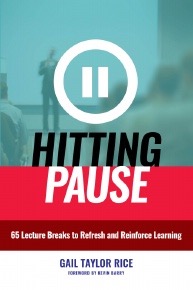class design
Select an item by clicking its checkbox

Hitting Pause: 65 Lecture Breaks to Refresh and Reinforce Learning
Date Reviewed: January 23, 2019
Timing is everything. It’s true for comedians and, according to Gail Taylor Rice, also for professors. Great comedians can hold an audience’s attention for over an hour because the attack-and-retreat nature of human attention. They know about volume control; high volume must be properly balanced with lower volume. Fast tempos must be tempered with slower tempos.
In the book Hitting Pause, Rice makes a compelling argument in favor of recognizing and designing classes in light of the rhythms of learning. Professors often suffer from the cognitive bias of "the curse of knowledge." This malady makes it nearly impossible for experts to put themselves in the shoes of someone who is learning things for the first time. A result of this curse is that it’s nearly impossible to appreciate how much time is needed for comprehending material.
Rice suggests that learners "might wish that there was a pause button connected to their college professors" (4). The pause button is a great metaphor. I think this idea could also be expanded as a highlighter pen for the lecturer. The professor needs to frequently slow down and make sure that students understand the importance of certain ideas.
The book rightly challenges the status quo of today’s university classroom as a place where professors read PowerPoint slides in darkened rooms while the gravitational pull of more interesting things like Instagram claim the student’s valuable and limited attention. Rice suggests that well-timed pausing can introduce the right kind of novelty and reflection to pull students out of their penchant for succumbing to time-wasting distractions.
Many educators believe the lecture is dead, and good professors will not use them. Lectures, however, aren’t necessarily bad; only bad lectures are bad. Rice offers solid research to give professors tested strategies for designing effective lectures that are punctuated with well-timed opportunities for reflection and emphasis.
According to Rice, starting a class with a pause invites students to become emotionally invested in learning. Again, we are so busy planning what we will teach that we forget to see things from a student’s perspective. An intentional pause forces us to think of starting a class like a pilot preparing for take-off. A good pilot will dutifully attend to a check-list to make sure that the plane is in good condition; teachers also need to consciously attend to their students’ current ability to learn.
The first half of Hitting Pause provides solid research about the pedagogical advantages of pausing. The second half contains numerous examples of starting pauses, mid-pauses, and closing pauses. Each example is categorized by appropriate setting and characteristics for use. The settings for use are divided into small classroom lecture, clinical or laboratory presentation, one-on-one session, conference presentations/in-service education, keynote/large-group presentation, course/unit, and online learning module. The characteristics include: affirming/positive, physical/movement, activates prior knowledge/experience, focuses/refocuses, creates community, generates curiosity, metacognitive, reviews, celebrates, commits to action, and provides a bookend. There are a great variety of examples which can be adapted to work in different settings.
Overall, this is a valuable book for teachers who are hoping to be more learning-centered.